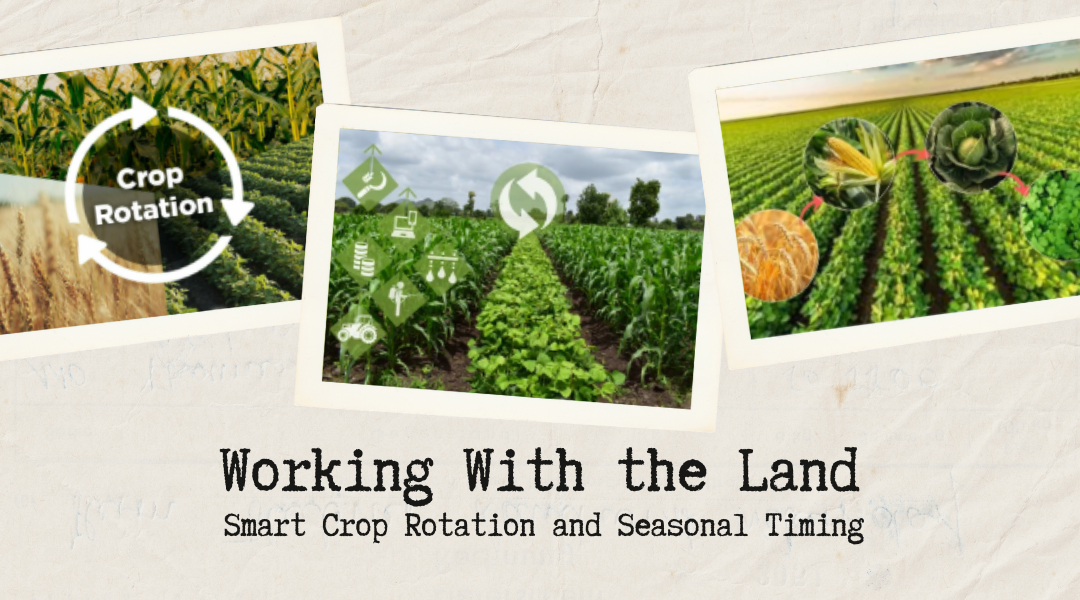Here’s the truth about organic farming: you can’t fight nature and win. The best growers don’t force the land—they listen to it. That means planting the right crops at the right time, and never letting the soil get stuck in a rut. Get this right, and your farm becomes more productive each year. Get it wrong, and you’ll battle pests, tired soil, and disappointing harvests.
Why Your Soil Needs a Crop Rotation Plan
Plant the same thing in the same spot year after year, and three things happen:
- Pests throw a party (their favorite buffet is always open)
- The soil gets drained of specific nutrients
- Diseases build up like a bad habit
The fix? Rotate like a pro:
- Year 1: Heavy feeders (corn, tomatoes) – they’re like teenagers, always hungry.
- Year 2: Nitrogen-fixers (beans, peas) – these legumes pay rent by adding nitrogen back to the soil.
- Year 3: Root crops (carrots, potatoes) – they break up compacted soil and scavenge deeper nutrients.
- Year 4: Rest year with a cover crop (clover or rye) – let the soil recover.
Real-world example: After your tomato patch gets hit with blight, follow it with garlic next season—its natural antifungals help clean the slate.
Planting By the Seasons (Not the Calendar)
Organic farming runs on nature’s clock, not Wall Street’s. Here’s how to sync up:
Spring:
- Cool-weather warriors: peas, spinach, radishes (they laugh at frost).
- Secret move: Plant potatoes when the dandelions bloom—nature’s soil thermometer.
Summer:
- Heat lovers: tomatoes, peppers, squash (wait until soil is warm—no rushing!).
- Pro trick: Sow quick crops like bush beans between slow-growers (melons, sweet corn).
Fall:
- Second spring: kale, beets, turnips (they sweeten after frost).
- Cover crops: Winter rye or hairy vetch protect bare soil from erosion.
Winter:
- Plan next year’s rotations (sketch it out now while you remember this season’s trouble spots).
- Let the chickens or pigs till your spent garden beds—they’ll fertilize while they work.
Sneaky Ways to Boost Yields Naturally
- The Three Sisters Trick
- Corn (trellis for beans)
- Beans (add nitrogen)
- Squash (living mulch that blocks weeds)
- Works because: They’re better together than apart.
- Stagger Your Planting
- Sow lettuce every 10 days = continuous harvest (not all at once).
- Missed your spring window? Try heat-tolerant “bolt-resistant” varieties.
- Let Plants Talk to Each Other
- Basil near tomatoes = fewer whiteflies + better flavor.
- Marigolds in the carrot patch = nematode protection.
- Work With Your Microclimate
- South-facing slope? Plant heat-lovers there 2 weeks early.
- Low spot stays damp? That’s your cabbage patch.
The Golden Rule: Feed the Soil, Not Just the Plants
All this planning falls flat if your soil is dead. Every fall, add:
- Compost (like a multivitamin for your land)
- Wood ash (for potassium, but only if your soil’s acidic)
- Leaf mold (the secret to moisture retention)
Test your soil every 2-3 years—not with fancy kits, but by:
- Watching where weeds grow (dandelions = compacted soil)
- Checking earthworm counts (5 per shovel = healthy)
The Bottom Line
Organic farming isn’t about doing more—it’s about working smarter. Rotate crops to outwit pests. Plant when nature says go, not when the garden center stocks seedlings. Most importantly, treat your soil like the living, breathing foundation it is.
The reward? Each season, your land gets richer, your harvests more reliable, and your farming more joyful. Because when you stop fighting the earth and start cooperating with it, that’s when the real magic happens.
